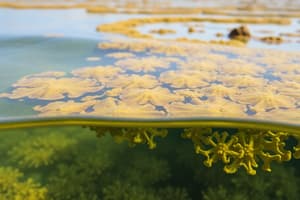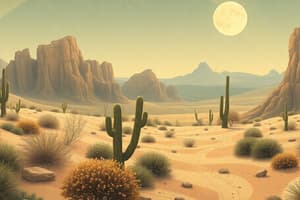Podcast
Questions and Answers
What is a significant consequence of overdependence on cash crops?
What is a significant consequence of overdependence on cash crops?
- Enhanced biodiversity
- Increased fish populations
- Reduction in pollution
- Habitat loss (correct)
What is overfishing?
What is overfishing?
- The removal of fish at a sustainable rate
- The introduction of new fish species into lakes
- Fishing species beyond their ability to replenish (correct)
- The increase of fish population in a specific area
Which of these factors is NOT mentioned as contributing to decreased biodiversity?
Which of these factors is NOT mentioned as contributing to decreased biodiversity?
- Ocean acidification
- Improved agricultural practices (correct)
- Introduction of invasive species
- Increased greenhouse gas emissions
How has globalization affected environmental awareness?
How has globalization affected environmental awareness?
Which impact of overfishing can lead to marine ecosystem imbalance?
Which impact of overfishing can lead to marine ecosystem imbalance?
What do unsustainable aquaculture practices contribute to?
What do unsustainable aquaculture practices contribute to?
Animal husbandry focuses primarily on which of the following?
Animal husbandry focuses primarily on which of the following?
What can result from the depletion of fish stocks due to overfishing?
What can result from the depletion of fish stocks due to overfishing?
What characterizes tropical forests?
What characterizes tropical forests?
Which biome experiences the lowest temperatures?
Which biome experiences the lowest temperatures?
What defines a desert biome?
What defines a desert biome?
What is a significant focus of environmental sociology?
What is a significant focus of environmental sociology?
Which issue is considered a major topic of research in environmental sociology today?
Which issue is considered a major topic of research in environmental sociology today?
What term is used to describe humans who move from one area to another?
What term is used to describe humans who move from one area to another?
Exponential population growth is characterized by which of the following conditions?
Exponential population growth is characterized by which of the following conditions?
Which resources are classified as renewable according to the provided content?
Which resources are classified as renewable according to the provided content?
Which field of study focuses on the relationships between political, economic, and social factors with environmental issues?
Which field of study focuses on the relationships between political, economic, and social factors with environmental issues?
What is the primary focus of anthropology as outlined in the content?
What is the primary focus of anthropology as outlined in the content?
What distinguishes political ecology from apolitical ecological studies?
What distinguishes political ecology from apolitical ecological studies?
Which of the following is an example of a non-renewable resource?
Which of the following is an example of a non-renewable resource?
How do the disciplines of anthropology and geography relate according to the content?
How do the disciplines of anthropology and geography relate according to the content?
What does the lithosphere consist of?
What does the lithosphere consist of?
Which sphere of the Earth includes oceans and rivers?
Which sphere of the Earth includes oceans and rivers?
Which biome is characterized by high rainfall and warm temperatures with tall vegetation?
Which biome is characterized by high rainfall and warm temperatures with tall vegetation?
What primarily influences the type of vegetation produced in an area?
What primarily influences the type of vegetation produced in an area?
What is the main difference between ecosystems and biomes?
What is the main difference between ecosystems and biomes?
Which statement accurately describes the biosphere?
Which statement accurately describes the biosphere?
Which of the following conditions would likely lead to minimal vegetation?
Which of the following conditions would likely lead to minimal vegetation?
What characterizes an ecosystem?
What characterizes an ecosystem?
What do sociologists investigate regarding climate change?
What do sociologists investigate regarding climate change?
Which of the following correctly pairs a biome with its possible species?
Which of the following correctly pairs a biome with its possible species?
How is the relationship between energy and the environment described?
How is the relationship between energy and the environment described?
What is a major concern in the economy and environment relationship?
What is a major concern in the economy and environment relationship?
Which aquatic species is noted for having gills and cold-blooded characteristics?
Which aquatic species is noted for having gills and cold-blooded characteristics?
Which of these is an example of a plant found in the grasslands biome?
Which of these is an example of a plant found in the grasslands biome?
Why is the study of politics, law, and public policy relevant to sociologists?
Why is the study of politics, law, and public policy relevant to sociologists?
In which biome would you likely find species such as rabbits and foxes?
In which biome would you likely find species such as rabbits and foxes?
What is a primary concern addressed by political ecology regarding environmental changes?
What is a primary concern addressed by political ecology regarding environmental changes?
What does political ecology critique regarding the enclosure of land for conservation?
What does political ecology critique regarding the enclosure of land for conservation?
Which aspect plays a crucial role in the definitions and practices studied in political ecology?
Which aspect plays a crucial role in the definitions and practices studied in political ecology?
What does Paul Robbins suggest about corporate and conservation interventions in political ecology?
What does Paul Robbins suggest about corporate and conservation interventions in political ecology?
How does political ecology aim to inform policymakers and organizations?
How does political ecology aim to inform policymakers and organizations?
What is one result of the unequal distribution of costs and benefits in environmental changes?
What is one result of the unequal distribution of costs and benefits in environmental changes?
What does political ecology advocate for in terms of resource management?
What does political ecology advocate for in terms of resource management?
Which of the following represents a misconception about the effects of environmental changes?
Which of the following represents a misconception about the effects of environmental changes?
Flashcards
Biome
Biome
A large, naturally occurring community of plants and animals that are adapted to a particular climate and geographic region.
Desert
Desert
A region where rainfall is less than 50 centimeters (20 inches) per year, characterized by dry conditions and low biodiversity.
Environmental Sociology
Environmental Sociology
A subfield of sociology that focuses on the interplay between society and the environment, examining how social structures and behaviors impact and are impacted by ecological systems.
Tundra
Tundra
Signup and view all the flashcards
Climate Change
Climate Change
Signup and view all the flashcards
Lithosphere
Lithosphere
Signup and view all the flashcards
Hydrosphere
Hydrosphere
Signup and view all the flashcards
Atmosphere
Atmosphere
Signup and view all the flashcards
Biosphere
Biosphere
Signup and view all the flashcards
Ecosystem
Ecosystem
Signup and view all the flashcards
Climate's Influence on Vegetation
Climate's Influence on Vegetation
Signup and view all the flashcards
Ecosystem vs. Biome
Ecosystem vs. Biome
Signup and view all the flashcards
Climate Change Sociology
Climate Change Sociology
Signup and view all the flashcards
Social Effects of Climate Change
Social Effects of Climate Change
Signup and view all the flashcards
Economy and Environment
Economy and Environment
Signup and view all the flashcards
Energy and Environment
Energy and Environment
Signup and view all the flashcards
Politics, Law, and Public Policy
Politics, Law, and Public Policy
Signup and view all the flashcards
Biome Shift
Biome Shift
Signup and view all the flashcards
Migration
Migration
Signup and view all the flashcards
Renewable Resources
Renewable Resources
Signup and view all the flashcards
Non-Renewable Resources
Non-Renewable Resources
Signup and view all the flashcards
Political Ecology
Political Ecology
Signup and view all the flashcards
Exponential Population Growth
Exponential Population Growth
Signup and view all the flashcards
Anthropology
Anthropology
Signup and view all the flashcards
Geography
Geography
Signup and view all the flashcards
Relationship between Anthropology and Geography
Relationship between Anthropology and Geography
Signup and view all the flashcards
Overfishing
Overfishing
Signup and view all the flashcards
Animal Husbandry
Animal Husbandry
Signup and view all the flashcards
Overdependence on Cash Crops
Overdependence on Cash Crops
Signup and view all the flashcards
Consumption and Production
Consumption and Production
Signup and view all the flashcards
Decreased Biodiversity
Decreased Biodiversity
Signup and view all the flashcards
Unsustainable Aquaculture
Unsustainable Aquaculture
Signup and view all the flashcards
Pollution
Pollution
Signup and view all the flashcards
Increased Environmental Awareness
Increased Environmental Awareness
Signup and view all the flashcards
Unequal Environmental Impacts
Unequal Environmental Impacts
Signup and view all the flashcards
Environment and Power
Environment and Power
Signup and view all the flashcards
Environmental Inequality and Power
Environmental Inequality and Power
Signup and view all the flashcards
Political Ecology's Normative Understanding
Political Ecology's Normative Understanding
Signup and view all the flashcards
Power Dynamics in Conservation
Power Dynamics in Conservation
Signup and view all the flashcards
Political Ecology and Economic Control
Political Ecology and Economic Control
Signup and view all the flashcards
Critiques and Alternatives in Political Ecology
Critiques and Alternatives in Political Ecology
Signup and view all the flashcards
Study Notes
Four Interacting Spheres
- Lithosphere: The solid part of Earth's crust, including rocks and soil.
- Hydrosphere: All Earth's water bodies (lakes, rivers, oceans, groundwater, ice caps).
- Atmosphere: The layer of gases surrounding Earth.
- Biosphere: The realm of living things (plants and animals).
Biomes
- Distinctive plant and animal species adapted to their environment.
- Classified as terrestrial (land-based) or aquatic (water-based).
- Differences in biomes are primarily due to climate (temperature and precipitation).
Ecosystems
- Specific areas where the interaction between Earth's spheres creates a unique collection of living organisms.
- Characterized by living (plants and animals) and non-living (climate, rocks, soil, water) components.
- Ecosystem components are interconnected; changes in one area impact others.
- Size differs from biomes, which are larger areas.
Five Major Parts of Biome
- Aquatic: Freshwater and marine biomes (ponds, rivers, lakes, oceans).
- Grasslands: Open regions dominated by grasses (tropical and temperate).
- Forests: Dominated by trees, with high biodiversity.
- Deserts: Dry areas (hot and cold deserts).
- Tundra: Extremely cold, inhospitable areas.
Climate
- The most important factor influencing the components of an ecosystem.
- Temperature and precipitation influence vegetation types within a biome.
Human Ecology
- Study of relationships between people and their environment.
- Considers the environment as an ecosystem that provides services to people.
Sustainable Development
- Meeting present needs without affecting future generations' ability to meet their own.
- Key to understanding the interactions between humans and the environment.
Political Ecology
- Study of relationships between political, economic, and social factors and environmental issues.
- Assumes changes in the environment affect societies unevenly.
- Examines how power relations influence environmental outcomes and policies.
Globalization's Environmental Impacts
- Increased transport of goods leads to emissions and habitat destruction.
- Specialization can cause habitat loss or resource overuse.
- Reduced biodiversity due to various environmental factors.
- Increased awareness of environmental issues.
Animal Husbandry
- Agriculture concerned with animals raised for meat, fiber, milk.
- Substantial environmental impact due to livestock farming.
Consumption and Production
- Relies on natural resources.
- Unsustainable practices lead to environmental problems like climate change and pollution.
Studying That Suits You
Use AI to generate personalized quizzes and flashcards to suit your learning preferences.




